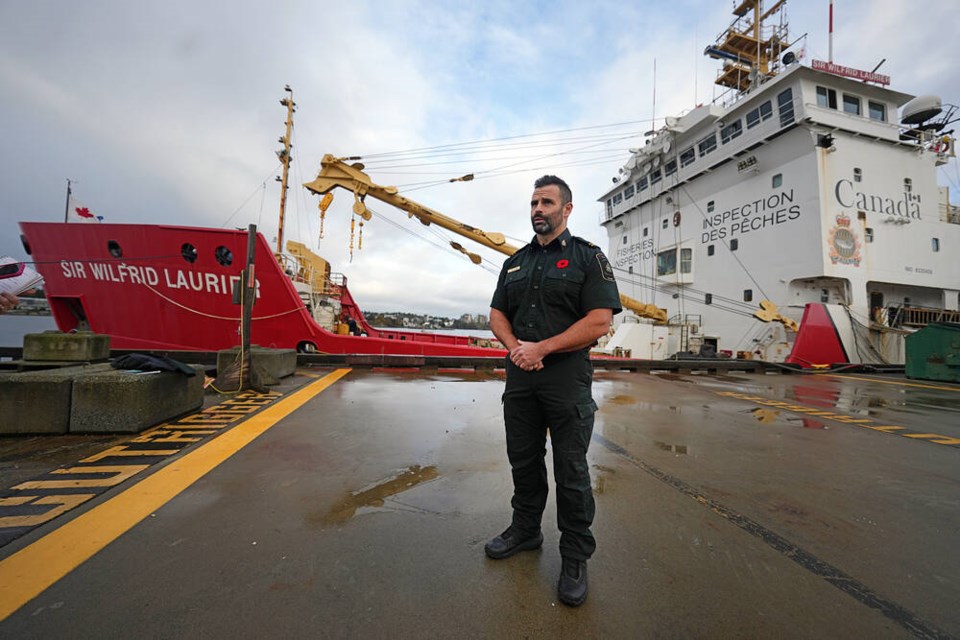Canada has flexed some muscle in the North Pacific, catching bad actors who continue killing sharks for their fins and others that take species that are out of season and key to the survival of B.C. salmon.
For the first time, a Canadian Coast Guard ship and fisheries officers led a mission to crack down on fishing fleets beyond the 200-nautical-mile limit that aren’t playing by international rules.
Operation North Pacific Guard, a two-month mission aboard the Victoria-based Sir Wilfred Laurier, covered more than 20,000 kilometres and involved armed Canadian fisheries authorities and other partners, including U.S. counterparts, boarding 15 international vessels.
Canadian fisheries officers were part of an international mission last year aboard a contracted ship with international partners and have been part of aerial reconnaissance for decades in the region.
But this was the first time a Canadian Coast Guard ship led the effort.
The crew documented several cases of marine pollution, patrolled for banned drift netting and cited several fishing boats — commonly known as “dark vessels” — for having their monitoring systems intentionally shut off.
The Sir Wilfred Laurier was supported by Canadian aerial surveillance based in Hokkaido, Japan in partnership with the Japanese and South Korean governments and satellite monitoring that pinpointed fishing-vessel locations.
The Sir Wilfred Laurier returned to home port on Sunday night. The crew said they would have boarded and sanctioned more vessels had it not been for their late start due to the ship’s lengthy engine refit, and stormy fall weather that made boardings difficult.
Dustin De Gagne, senior officer with the Department of Fisheries and Oceans International Fisheries Enforcement Unit, said officers encountered multiple cases of illegal shark finning, misreporting of catches, vessel-marking issues and boats not using the required transponders so they can transmit their locations to authorities.
The crew also found one ship with a significant illegal catch of Pacific saury, a small fish similar to herring and a keystone species in the North Pacific.
De Gagne said one ship was caught with 20 tonnes of saury out of season, valued at $3 million Cdn.
“It’s an important species for the North Pacific ecosystem and a forage species for Pacific salmon,” he said. “So it’s important that we’re out there not only looking for potential interception of Pacific salmon in by-catch, but species which are vital to their offshore life cycle, feeding patterns and diet.”
The boardings gave Canadian officers their first opportunity to enforce the newly adopted ban on Pacific salmon retention, which has been in effect for North Pacific fishing fleets since July.
Fisheries officials did not specify the country of origin of the vessels found with illegal catches or infractions, but did say those stopped and boarded were part of Asian “distant-water fleets,” flagged to China, Taiwan, Japan, Korea and Russia.
Canadian fishery officers are not permitted to seize illegal catches, but the Department of Fisheries and Oceans said it works with the ships’ flag states to support further investigations and sanctions on offending vessels.
“We do provide a comprehensive report to the flag state and they are held accountable to the international community to ensure they investigate fully and then sanction those illegal actors accordingly,” said De Gagne.
Asked if he was confident countries would act on illegal fishers, De Gagne said those countries found in contravention are held accountable to a larger community consisting of members of international fisheries organizations.
“They are obliged to report on their findings and if those results are not deemed to be sufficient, an inspecting country like Canada can propose to have that vessel prohibited from future fishing,” he said. “That’s called an IUU [Illegal, Unregulated, Unreported] fishing listing and that’s something these countries don’t want, so they will usually work with inspecting members.”
Air crews patrolled 50,000 nautical miles and visually inspected 407 vessels over the course of 34 patrols. During those patrols, fishery officers “reported incidents of shark finning, the targeted harvest of dolphins, pollution incidents and vessel marking violations,” DFO said.
In addition to monitoring and enforcement, fishery officers collected environmental data and water samples, including the migration range of species of interest, such as Pacific salmon, and the levels of microplastics in the water.
This year’s mission also marked two firsts for the Canadian Coast Guard — the first port visit of a coast guard vessel to Japan, and the first use of an eco-friendlier blend of renewable diesel, biodiesel and conventional diesel, marking a significant step toward a greener fleet and a federal mandate to be carbon neutral by 2050.
The Sir Wilfred Laurier went through a refit this year to replace its three engines and controls. The new blend of fuel reduced emissions by 80% and fuel oil and lube oil consumption by half.
Capt. Richard Marriott, who has served on the Sir Wilfred Laurier for two decades, said the light icebreaker is “the jackknife off all trades when it comes to multitasking operations.”
He said adding fisheries operations in the North Pacific was a perfect fit for the ships, which was involved in everything from finding the Franklin Expedition wrecks to vital transport and supply in the north and scientific expeditions.
“It’s a very well-equipped vessel for any type of mission and we showed it again in this time,” said Marriott.



